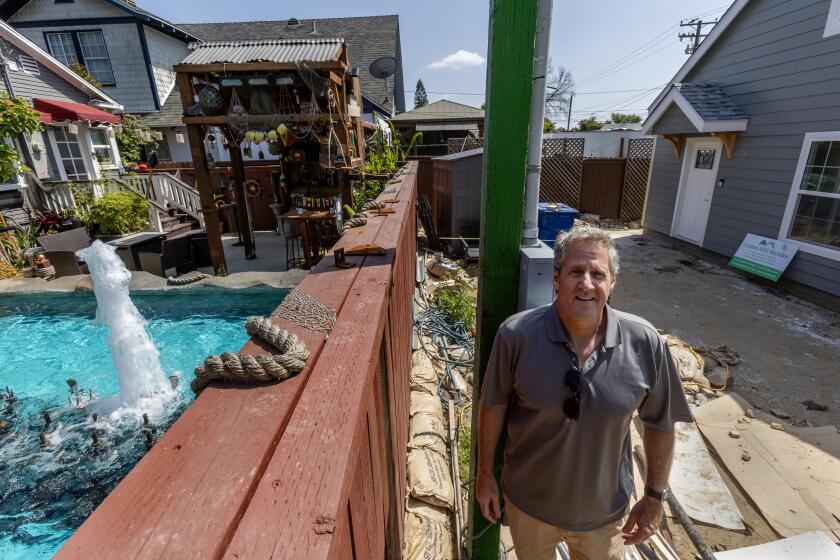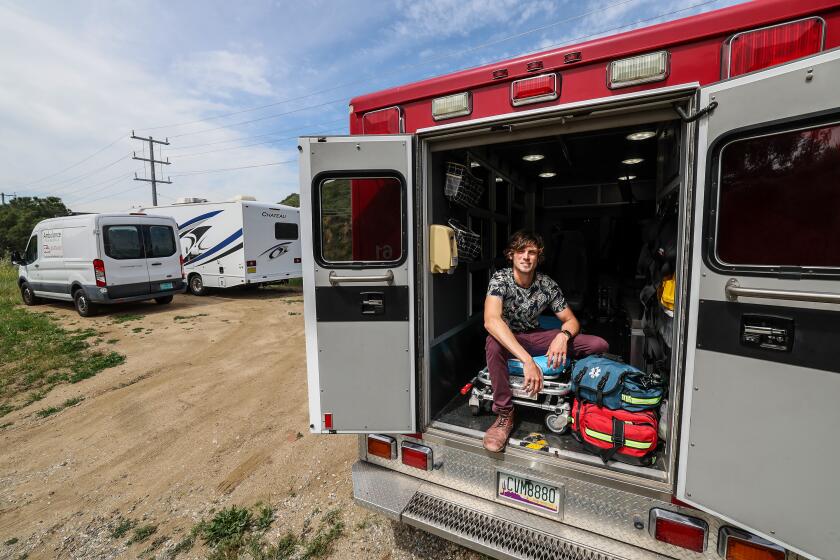Developers, industry battle for L.A.’s heart
The old warehouse at the corner of Industrial and Mateo streets in downtown Los Angeles had seen better days when Yuval Bar-Zemer and his partners at the Linear City development firm bought it in 2002.
The 1924 structure, in a rundown section of downtown, was a World War II-era bomb shelter and later a toy factory. It was being used to store the plush shells of stuffed animals.
The developers transformed it into 119 live-work units, with a rooftop pool and other communal amenities. They dubbed the new space Toy Factory Lofts. On the building’s ground floor are a pub-style restaurant, a high-end grocery store and a health club.
And this weekend, the developers finished work across the street converting the former West Coast headquarters of the Nabisco company into 104 live-work condo units.
But what might seem like a tale of urban renaissance is actually at the center of a fierce battle brewing in downtown L.A. that pits the shiny new downtown against the gritty version that has long existed in the heart of the city.
Developers like Bar-Zemer are pushing Los Angeles to radically rezone the city’s industrial core to allow residential development. They argue that the change would create a new type of neighborhood, one that would mix light industry with condo living and live-work lofts -- spaces where artists, architects and others can operate businesses and sleep at night -- and would ultimately create more jobs and tax revenue for the city.
The city Planning Department and some community activists, however, are resisting the heavy lobbying. They say the industrial zones provide solid jobs for the working class and boost L.A.’s economy.
“In the rush to build some downtown fantasy, we should be careful not to destroy the things about downtown that actually work,” said Joel Kotkin, an urban planner who has written extensively about L.A.’s economy. “The industrial stuff actually works: It employs a lot of people, there’s a low vacancy rate, and being at the center of a transportation hub really matters.”
At stake is the future of the city’s industrial land -- and not just in downtown.
About 8% of the city -- or 19,000 acres -- is zoned for industrial use, mostly properties used for manufacturing, storage, distribution and other commercial operations. Although the debate now centers on the vast tracts around downtown, where the largest concentration of the industrial land is located, the proposed changes could have a ripple effect elsewhere, including Hollywood, the Westside and the San Fernando Valley.
The debate goes beyond issues of planning, zoning or architecture, say most people familiar with the discussions, and centers on the very nature of what a city is supposed to be, and who it should be for.
“We need as a city to move away from our 1950s-era suburban-model approach to zoning and instead devise land-use regulations that combine uses, to create jobs and housing on one site at one time,” said Kate Bartolo, senior vice president of development for the Kor Group, which is developing a number of projects downtown, including the conversion of the former Barker Bros. furniture warehouses in the industrial district into condos and retail space.
The debate exemplifies how the economics of revitalization are rapidly changing Los Angeles.
As the boom in downtown residential real estate moves into the industrial district, aging factory spaces are suddenly worth more if converted into lofts. That’s because large industrial living spaces are selling for a premium, costing $500,000 or more for each unit.
Because of this, many owners of industrial businesses are conflicted, because they see the economic benefits of residential conversion.
A city report placed the price of land for residential uses downtown at roughly five times that of industrial land. If the industrial land downtown is rezoned, city officials say, that value could rise even more sharply.
At the same time, however, the city found that the industrial district around downtown supports 64,000 jobs, most of which pay around $19 to $24 an hour (though some developers say those numbers are somewhat inflated).
For more than 100 years, downtown has been the heart of industrial L.A. -- ever since the Southern Pacific Railroad opened L.A.’s first rail depot there in the late 1800s.
As the city grew, so did the district, and brick buildings began to dot the nearby landscape, built to handle the vast number of goods coming into the region.
By the 1920s, national firms began locating their West Coast branches in the city center, said Greg Hise, an associate professor of urban history at USC’s School of Policy, Planning and Development.
Today, though, the downtown warehouse district is a tangled mix of industry and neglect.
The district’s streets are, quite literally, crumbling, riddled with cracks, the skeletons of old rail lines and wheel-size potholes. Few of the area’s loading docks, built decades ago, can accommodate modern semi trucks.
Still, with their fences lined with barbed wire and graffiti, most of the district’s low-slung buildings are occupied, home to cold storage facilities, produce companies, toy storage and more.
City officials say that the vacancy rate for downtown’s industrial land hovers around 1%, and that demand for certain-sized parcels can’t be met by the current supply.
A recent analysis commissioned by the city predicted that the market for sites could become even tighter, as industrial tenants seeking bigger spaces come face to face with developers in search of the next “it” neighborhood.
Bar-Zemer and other developers argue that simply relying on the time-honored roles for downtown buildings is not what’s best for creating a teeming, vital downtown.
He and others look at the decaying warehouses and argue that the hip, old buildings with great bones and a lot of floor space would be better off as high-density housing. They have the support of the area’s major business groups and City Council members Jose Huizar and Jan Perry, who represent downtown.
“We don’t want a residential neighborhood -- that is exactly what we don’t want,” Bar-Zemer said. “We want an interaction between housing and work spaces. That could happen within a unit, within a building, within the block. It demands a level of flexibility.”
Other developers agree with that line of reasoning. “Saying that industrial is wholly incompatible with live-work lofts is very dated thinking,” said Bartolo, whose firm is also behind the Molino Lofts in the industrial district and the Pegasus, Santa Fe and Eastern Columbia buildings farther west in downtown.
“Much of downtown’s new industrial growth is compatible with live-work uses,” Bartolo said. “This new industrial tenant -- from apparel to new media--functions more like an office tenant than the old smokestack industries.”
They say that more live-work spaces will mean residents use their cars less -- something city officials are trying to promote. (City planners counter that many industrial workers already live within a few miles of downtown and often use mass transit).
The analysis conducted for the city by Keyser and Marston, a real estate advisory firm, concluded that changing the zoning of downtown’s industrial land from industrial to residential “would confer substantial additional land value.”
For city planners, there is a palpable fear that those “industrial users” would take their businesses and their good-paying jobs and tax dollars to more industry-friendly cities such as Vernon or Duarte. This is likely to become an issue when the L.A. Planning Commission and City Council take up the matter in the coming weeks.
“We are looking at it from the big-picture point of view,” said Jane Blumenfeld, a city planner. “We are trying to make public policy.... The reason you have these rules and regulations in a city is to intervene when you have to intervene, for public purposes.”
Dan Murphy, the general manager for California Drop Forge, said his company, which supplies parts to commercial and defense aerospace companies, has operated out of a downtown warehouse for more than 100 years.
He said it would be difficult for the company to find space for its operations elsewhere. It uses forging hammers, presses, furnaces and a large boiler.
Murphy added that the company, which has 76 people at its site near Chinatown and pays wages up to $31 an hour, is concerned that changes in the zoning laws could have a “negative impact.”
“We see the money spent downtown on all the housing,” Murphy said. “But at the same time, we hope the city understands the need for an industrial base down here.”




